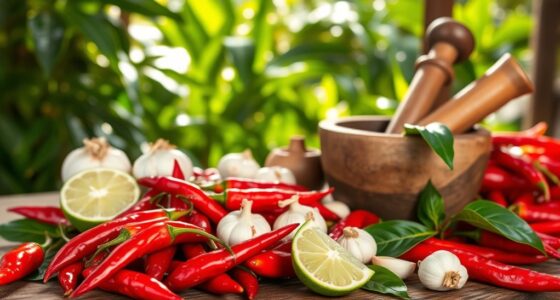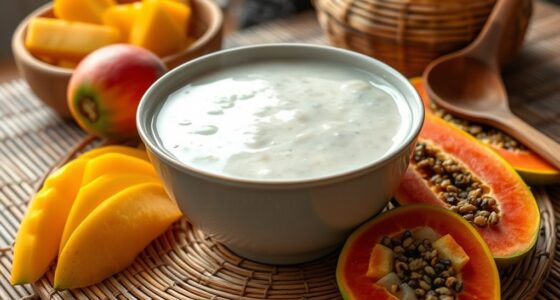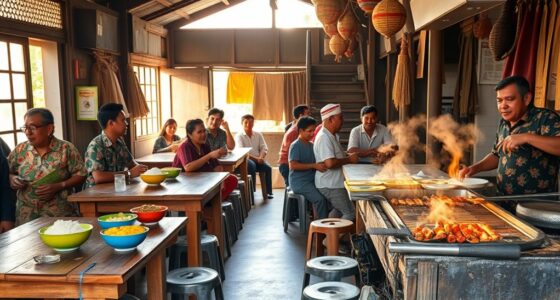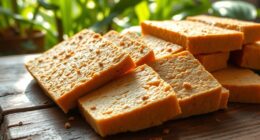Martabak manis is a popular Indonesian street food that reflects the country’s rich cultural history and culinary creativity. You’ll find a thick, sweet pancake filled with toppings like peanuts, chocolate, cheese, and jam. Its origins blend Middle Eastern, Indian, and local influences, making each bite a story of cultural exchange. Preparation varies across regions, showcasing Indonesia’s vibrant food scene. Keep exploring to discover more about this delicious symbol of Indonesia’s diverse heritage.
Key Takeaways
- Martabak manis is an Indonesian sweet pancake with Middle Eastern and Indian roots, reflecting Indonesia’s cultural exchange history.
- Its batter combines flour, sugar, yeast, and milk, topped with ingredients like peanuts, chocolate, cheese, and jams.
- The preparation involves pouring batter into a hot pan, adding toppings, and cooking until golden with crispy edges.
- It holds cultural significance as a popular street food symbolizing Indonesia’s diverse culinary heritage.
- Each variation showcases regional flavors and ingredients, embodying Indonesia’s rich, evolving food tradition.

Street-food lovers often flock to the vibrant stalls that serve martabak manis, a popular Indonesian sweet pancake. This treat is more than just a dessert; it’s a reflection of Indonesia’s rich cultural tapestry. The origins of martabak manis trace back to the Middle Eastern and Indian influences brought to Southeast Asia by traders centuries ago. Over time, it evolved uniquely within Indonesia, blending local tastes and ingredients into a beloved snack. Its history is a testament to cultural exchange, borrowing techniques and flavors that have been adapted to local preferences. As a result, each region might boast its own version, but the core concept remains consistent: a thick, sweet pancake filled with a variety of toppings.
Street-food fans cherish martabak manis, a sweet Indonesian pancake with rich cultural roots and regional variations.
When you explore martabak manis, you’ll quickly notice the ingredient variations that make each bite special. The batter itself is typically made from a mixture of flour, sugar, yeast, and milk, creating a soft, chewy base. However, the toppings and fillings are where the creativity shines. Common ingredients include crushed peanuts, sesame seeds, chocolate sprinkles, and sweetened condensed milk—each adding a different texture and flavor profile. Some stalls experiment with cheese, butter, or even fruit jams, catering to diverse tastes. You might find versions that are gooey and rich or light and crispy, depending on the preparation method and regional preferences. Additionally, the use of specific ingredients often reflects local cultural influences and regional availability.
The preparation process involves pouring the batter into a hot pan, then covering it with toppings before it’s cooked until golden and slightly caramelized. The key is to balance the sweetness and texture, creating a pancake that’s crispy on the edges but soft inside. Vendors often have their secret recipes, and some may add a pinch of spices like cardamom or cinnamon to enhance the flavor. The variations in ingredients and preparation styles reflect Indonesia’s multicultural influences, making each martabak manis a unique experience.
Ultimately, your journey through street food stalls will reveal how deeply this snack is woven into Indonesian culture. It’s a culinary canvas that showcases local tastes and innovations, rooted in its historical origins but ever-evolving. Whether you prefer it simple with just sugar and nuts or loaded with chocolate and cheese, martabak manis offers a delicious snapshot of Indonesia’s vibrant food scene. Every bite tells a story of cultural exchange, adaptation, and creativity—an authentic taste of Indonesia’s rich, diverse heritage.
Frequently Asked Questions
What Are the Origins of Martabak Manis?
You might wonder about the origins of martabak manis. It’s a beloved Indonesian sweet with deep cultural significance, often shared during special occasions. Its history traces back to Middle Eastern influences, adapted over time with regional variations across Indonesia. You’ll find different fillings and toppings, reflecting local tastes. This street food’s vibrant history shows how it’s become a staple that connects communities through its rich flavors and cultural importance.
How Is Martabak Manis Traditionally Prepared?
So, you think making martabak manis is just mixing batter and flipping? Think again. You’ll need precise cooking techniques to get that perfect golden crust and soft, gooey center. Presentation styles matter, too—often topped with butter, chocolate, or condensed milk. You pour, cook, and fold with care, turning simple ingredients into a delightful treat. Practice makes perfect, and every bite tells a story of skill and tradition.
What Variations of Martabak Manis Exist Across Indonesia?
You’ll find that martabak manis varies across Indonesia, reflecting regional toppings and cultural influences. In some areas, you might enjoy sweeter versions with chocolate, cheese, or condensed milk, while others feature unique toppings like peanuts or fruit. These variations showcase local tastes and traditions, making each region’s martabak manis a delightful reflection of its cultural identity. You’ll notice how these regional differences add richness to this beloved street food.
Which Ingredients Are Essential for Authentic Martabak Manis?
Imagine you’re savoring a freshly made martabak manis; the essential ingredients include a rich, leavened batter made from flour, eggs, sugar, and milk, creating its signature chewy texture. Authentic flavor combinations often feature sweet toppings like chocolate, sesame, and butter, while regional ingredients like pandan or coconut elevate the taste. These core elements guarantee you enjoy a genuine, flavorful experience, reflecting Indonesia’s diverse culinary traditions.
How Has Martabak Manis Evolved With Modern Flavors?
You’ve probably noticed that martabak manis has evolved with modern flavors through fusion creations and creative toppings. Today, vendors experiment with ingredients like Nutella, cheese, and colorful sprinkles, blending traditional sweetness with contemporary tastes. These innovations make the treat more exciting and personalized, appealing to diverse palates. As a result, martabak manis stays relevant, transforming into a versatile dessert that celebrates both its heritage and inventive culinary trends.
Conclusion
So, next time you see a street vendor offering martabak manis, don’t hesitate to try it. Its rich, sweet layers may seem indulgent, but they reflect a cultural craft passed down through generations. While some might argue it’s just a dessert, it’s actually a demonstration to Indonesia’s vibrant culinary heritage. Embrace the experience—each bite connects you to a centuries-old tradition of street-food artistry.









